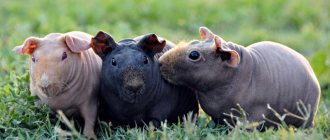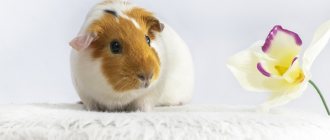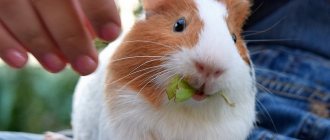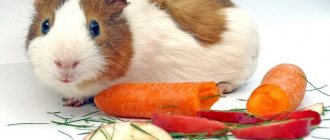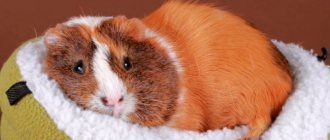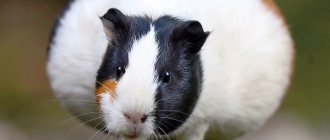The guinea pig (lat. Cavia porcellus) would probably be very surprised if she learned about its Russian-language name, because it has nothing in common with either real pigs or the sea. Then why is it called that way?
flickr/pyza*
Everything is very simple: it became “marine” because it was brought from America, i.e. from across the sea. Although it would probably be more correct to call it “overseas”. In Europe, it is most often called "Guinea pig", "pig mouse" or "Indian pig". As you can see, only the word “pig” does not cause controversy. Why? Because this animal sometimes makes grunting sounds, just like its big namesake.
The Andean tribes of South America were the first to domesticate guinea pigs 5 thousand years ago. True, then they were not just pets. People used them as a source of tasty meat or as sacrifices for various rituals and ceremonies. Since the 13th century AD. Indian tribes became seriously interested in breeding them and, before the conquest of the Inca Empire in 1533, managed to develop many different breeds.
flickr/pyza*
Of course, modern breeders have gone even further. Today there are a huge number of varieties of guinea pigs that are completely different from each other. For example, in pet stores you can find both long-haired animals, as well as wire-haired, short-haired and even animals with no hair at all or with a little fluff.
In general, guinea pigs have a body length of 25 to 35 cm, they have a wide blunt muzzle with floppy ears, a large body with rounded shapes and no tail at all. Males weigh from 1 to 1.5 kg, females - from 0.8 to 1.2 kg. In wild individuals, the natural color of the upper body is brownish-gray, the belly and the inside of the paws are lighter.
flickr/pyza*
These are quite cute pets with a good-natured and trusting character. They love to sit in their arms and play with their owner. However, during such activities you should be very careful, since a fall even from a small height can have very sad consequences for the animal.
Interestingly, guinea pigs, in addition to grunting, can make many other different sounds. For example, when they are happy, they may purr. Males sometimes purr when courting. Females, during pregnancy or in the absence of a male, begin to chirp like birds. They do this at night, continuing their “song” from 2 to 10 minutes. True, this happens extremely rarely.
flickr/pyza*
Guinea pigs eat hay, grain feed, juicy vegetables and fruits. When feeding, it should be taken into account that fresh hay should be kept in the cage around the clock, since the animal uses it to grind down its teeth, in addition, it helps to normalize the functioning of the digestive system.
Sometimes the animal can be caught in a not very pleasant procedure - eating its own droppings. He inherited this habit from his wild ancestors - it turns out that in this way guinea pigs are enriched with vitamins, since vitamins B and K are absorbed in the animal’s body only when they repeatedly pass through the gastrointestinal tract.
It is better to keep them in pairs or small same-sex groups - loneliness makes guinea pigs very worried, which leads to overeating and a shortened lifespan.
So…
Description of the rodent
— Advertising —
The body length of a guinea pig is 25-35 cm depending on the breed, the body is round in shape, there is no tail, the ears are hanging, the muzzle is wide and blunt. The weight of an adult male ranges from 1 to 1.5 kg, the female usually weighs a little less, from 800 to 1200 g. The natural color of the guinea pig is brownish-grayish, the tummy and paws are light on the inside.
Guinea pig nutritional features
Due to the structure of the digestive tract, guinea pigs eat often, but in small portions. The main food for them is high-quality hay, which they need both in winter and summer. Hay normalizes the digestive system of animals and also promotes proper grinding of teeth. At home, hay is always left in the cage; the norm for dry food is 1 tablespoon per pig per day.
The second place in a rodent's diet is occupied by succulent food (apples, lettuce, carrots, beets, cabbage and other vegetables). Sweet fruits and berries will be an excellent treat for guinea pigs. Such food is a source of ascorbic acid for the animal.
— Advertising —
To grind down the front teeth, twigs of apple, cherry, celery and dandelion roots are suitable.
A drinking bowl with clean water is also installed in the guinea pig’s cage; the volume per pig is at least 250 ml. Females drink more water during pregnancy and nursing. The water is changed every day.
As herbivores, guinea pigs should not be fed animal products such as milk or raw or fried meat. This can cause digestive problems.
Interestingly, guinea pigs often eat their own droppings, and there is no need to prohibit them from doing so. The fact is that B vitamins and vitamin K are absorbed in their bodies only after passing through the digestive system again. That is, eating droppings ensures the health of guinea pigs.
Natural enemies of pigs
Guinea pigs have plenty of enemies in the wild. After all, small defenseless cavias become easy prey for both terrestrial and feathered predators. Therefore, furry rodents always have to be on alert in order to warn the rest of the group in case of danger and give them a chance to survive.
A wild guinea pig must always remain alert in order to spot a predator in time
The main enemies of guinea pigs are representatives of the cat family. The animals are hunted by the mysterious jaguarundis and spotted ocelots. The wild Chilean cat also hunts pigs. And rodents living at the foot of the mountains can become victims of such a predator as the Andean cat. And of course, these creatures have to be wary of the formidable pumas, who will never miss the opportunity to feast on the tender meat of the cavy.
During night feeding, guinea pigs often fall into the claws of owls, eagle owls and hawks. And in the forest thickets and among the rocky cliffs, snakes lurk in anticipation of prey, which with a lightning-fast throw overtake the furry animal, killing it with their poison.
Common Guinea Pig Types
Today, many decorative breeds of guinea pigs have been developed, which differ in the structure, length and color of their coat. Breeds of domestic guinea pigs are divided into the following groups:
- short-haired (selfies, cresteds, smooth-haired);
- Wire-haired (Abyssinians, American Teddies, Rexes);
- breeds without hair and with a small amount of it (Baldwin, Skinny).
long-haired (Sheltie, Texel, Peruvian, Merino, Angora);
Domestic guinea pigs also differ from their wild counterparts in having a more rounded body shape. When crossing within a breed, it is possible to obtain beautiful tri-colored tortoiseshell and white guinea pigs, which are called “cakes”, since their spots are inherited in a chaotic manner. To breed this breed, a large population is required: more than 100 guinea pigs, as a result of crossing which “by chance” the best combination of spots is obtained.
The lifespan of cake guinea pigs is up to 10 years, average weight is about 1.6 kg, body length is up to 35 cm.
Appearance
If you look at a photo of a guinea pig in the wild, at first it may seem that this is an ordinary hare. He has the same gray color, with a slight touch of red, and cowardly behavior characteristic of our long-eared cats.
Although cowardice is not a bad trait, because pigs are hunted by many wild animals, from large birds of prey to wolves.
Red and gray colors are determined by living conditions. After all, there are grasses and rocks in the area. The pigs have fur that matches the color of the landscape, making it easier to hide. The animal has a very interesting fur structure. The hair itself is gray, has a red tint in the middle, and black at the tip.
The size of a guinea pig in the wild does not exceed 35 centimeters in length, and its weight does not exceed 3 kilograms. The animals have an elongated body, unlike domesticated ones. Therefore, there are much more external differences between domestic and wild animals than there are similarities.
Animals living in their natural environment are strong and hardy, weigh less and are very playful. Another cardinal difference is the color; in wild animals it is not so bright.
The life of guinea pigs in the wild occurs mainly at dusk. During the day they usually hide. And the “houses” are completely dependent on the environment. In mountainous areas this may be a crevice. On the plains, the animal digs minks, but more often it occupies the housing of other rodents, or creates a shelter of grasses and shrubs.
Guinea pigs tolerate sudden changes in temperature well. They are not afraid of cold temperatures down to +5 degrees and extreme heat when the air temperature rises to +45 degrees. In severe frosts, animals can die, which happens mainly with weak or too young individuals.
These are very clean representatives of wild fauna; they are almost completely odorless. They devote all their free time to cleaning their fur coats. Although this quality is associated not only with cleanliness, because the absence of smell makes it possible not to attract enemies again.
Guinea pig behavior
Guinea pigs are a very popular pet, they are trusting and peaceful. They are even taught to respond to their nickname. When petted, the animals purr and love to sit in a person’s arms.
The guinea pig cage is cleaned 1-3 times a week. Pressed sawdust and shavings are used as bedding. The litter is changed once every 5 days.
The average life expectancy of guinea pigs is 5 years, with good care - up to 8 years.
Drinker and feeder
In addition to the house, the guinea pig will need two feeders and a drinking bowl. It is better to buy a vertical ball drinker; with a simple bowl it will not be so convenient: filler may get into the water, which will make it unsuitable for consumption. The water needs to be changed every day, even if it seems that the animal is not drinking at all.
flickr/pyza*
For dry and wet food, you should purchase two separate feeders. They must be quite heavy and stable, otherwise the mobile animal will constantly turn them over. You can even attach one of them to the cage, and put the second one (for wet food) from time to time.
Guinea pig breeding
After mating, the male is placed in a separate cage so that he does not provoke a miscarriage. The pregnancy of a female guinea pig lasts 60-72 days. There are from 1 to 6 babies in one litter. The female is solely responsible for caring for the offspring.
In some cases, after giving birth, the female does not break the membrane with the fetus. Then you need to carefully open it with clean hands. Without outside help, in such a situation, only those babies who were able to chew the shell on their own survive.
Little guinea pigs become independent a month after birth, at the same age they reach sexual maturity and readiness to reproduce.
When breeding guinea pigs up to 1 month, the babies are left with the female, after which the young animals are separated separately by gender. The male is placed with the female only after six months, so that she has time to fully recover.
Interesting facts about the rodent:
- Guinea pigs were domesticated in the 5th millennium BC. e. Andean tribes of South America (today Colombia, Ecuador, Peru and Bolivia) in order to eat rodent meat. During archaeological excavations in Peru and Ecuador, statues of guinea pigs were found dating back to 500 BC. e. before 500 AD e. They were worshiped by the Mochica people. Nowadays, in South America, guinea pigs continue to be eaten (in Peru, up to 65 million animals are used for this purpose per year). Guinea pig meat is similar in taste and nutritional value to rabbit and chicken meat, and is considered dietary.
- Selection work to develop guinea pig breeds lasted from 1200 to 1532. And during the period of the Great Geographical Discoveries, traders from Spain, Holland and England brought pigs to Europe, where they gained popularity as pets at royal courts (for example, Queen Elizabeth I of England).
- The scientific name of the species "Cavia porcellus" is Latin for "little pig". Breeders often use the more formal name cavy or cavey. The comparison of these animals with pigs is not entirely clear. Possible causes include the characteristic sounds guinea pigs make, the proportions of their head to body size, their thick necks, and lack of a waist. In addition, guinea pigs constantly eat and live in small pens that were used to breed pigs on ships, which makes them generally similar to ordinary pigs.
- Guinea pigs are capable of making a variety of sounds, each of which has its own designation. So, during pregnancy, females, and sometimes males too, make chirping sounds that are vaguely similar to birdsong. Guinea pigs “chirp” for 2 to 15 minutes, usually at dusk or at night. When courting females, males make rumbling sounds, a kind of “mating song.” Similar sounds are also characteristic of dominant pigs, which live together with a group of relatives, and with their help show which of them is in charge.
- Penicillin is a deadly poison for guinea pigs.
Origin of the name
Translated from Latin, the word Cavia means small pig. The same term exists in the Galibi tribal language (South America). All over the world, the name Guinea pig is better known, but in Russia the prefix “marine” is used. It is believed that this term came to us from the Polish language “swinka morska”, which was once transformed from the German word Meerschweinchen.
It’s not clear where the prefix “Guinean” came from. It is believed that it is a purely nominal epithet, meaning that the animal was brought from distant countries.
